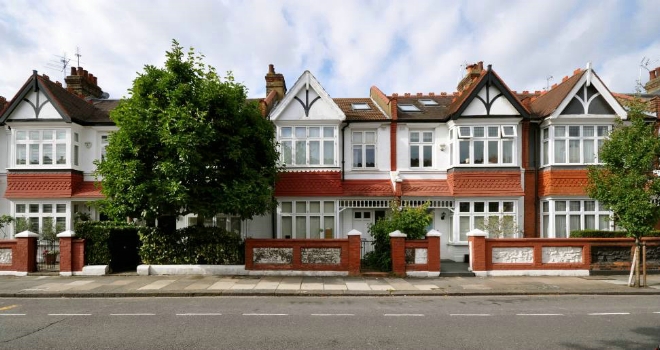
"The sharp increase in borrowing costs is likely to exert a significant drag on housing market activity in the near term."
Annual house price changes were "broadly stable" at -3.5% in June, little changed from the 3.4% decline recorded in May, according to the latest Nationwide house price index.
Prices were also fairly stable over the month, rising by 0.1%, reversing the 0.1% decline seen in May.
The data shows that all regions except Northern Ireland recorded annual price falls in Q2.
Northern Ireland saw a modest 0.7% year-on-year price rise, making it the best performing region. Meanwhile, East Anglia was the weakest performing region, with prices down 4.7% compared with a year ago.
All English regions saw a slowing in the annual rate of change compared with last quarter. London saw a 4.3% year-on-year decline, while the surrounding Outer Metropolitan region saw a 2.9% fall.
Across northern England overall, prices were down 2.7% compared with Q2 2022. The North West was the weakest performing northern region, with prices down 4.1% year-on-year. Meanwhile southern England saw a 3.8% decline.
Scotland saw a slight improvement in the annual rate of change to -1.5%, from -3.1% last quarter. Meanwhile Wales saw a further slowing in annual house price growth from -0.7% to -1.7%.
Robert Gardner, Nationwide's chief economist, said: “Longer term borrowing costs have risen to levels similar to those prevailing in the wake of the mini-Budget last year, but this has yet to have the same negative impact on sentiment. For example, the number of mortgage applications has not yet declined and indicators of consumer confidence have continued to improve, though they remain below long run averages.
“The sharp increase in borrowing costs is likely to exert a significant drag on housing market activity in the near term.
“Moreover, house prices remain high relative to earnings, and as a result, deposit requirements are still a significant barrier for those looking to enter the market. A 10% deposit on a typical first-time buyer home is equal to around 55% of gross annual income – this is down from the all-time highs of 59% prevailing in late 2022, but still marginally above the levels prevailing before the financial crisis struck in 2007/8.
“Moreover, despite the higher interest rates available to savers, the sharp rise in rents, together with continued high rates of inflation more generally is continuing to make it difficult for many prospective buyers to save for a deposit.
“Nevertheless, a relatively soft landing is still possible, providing the broader economy performs as we (and most other forecasters) expect.
“Labour market conditions are expected to remain relatively robust, with the unemployment rate remaining below 5%, while income growth is projected to remain solid. With Bank Rate likely to peak in the quarters ahead, longer term interest rates should also start to fall back.
“As a result, a combination of healthy rates of income growth and modest price declines should improve affordability over time, especially if mortgage rates moderate."
Nicky Stevenson, managing director at national estate agent group Fine & Country, commented: “The housing market remains resilient, with prices broadly stable over the month, but buyers are feeling affordability pressures amid rising mortgage rates.
“However, the prospect of being able to negotiate for a better price is drawing more buyers to the market.
“Mortgage approvals, an indicator of future sales, rose again in May compared to the previous month, suggesting that people are still eager to move home.
“Buyers are benefiting from rising stock levels which give them much greater choice and more breathing room to make a decision about their next home. This is in contrast to 2021 and 2022, where best and final offers became the norm for many sales.
“Despite this, stubborn inflation and more rate rises could still dampen house price growth in the coming months.
“Thankfully, the agreement from banks and building societies that they will offer flexibility and support to struggling mortgage-holders should help to prevent significant forced-selling and repossessions. Combined with a strong labour market, these measures should help give the property market a soft landing.”
Iain McKenzie, CEO of The Guild of Property Professionals, added: “While house prices are down year on year, they are holding steady now in the face of tougher market conditions, which should provide some much-needed reassurance to buyers and sellers alike.
“A levelling out of prices will be welcome news to homeowners who have seen their property’s value soften in the first half of this year.
“Interestingly, Northern Ireland is outperforming any other region of the UK on house prices, showing not only resilience but also continuing annual growth.
“This confidence is reflected in what we are seeing on the ground, with the majority of potential buyers hoping to get on the property ladder in the next few months. Despite worries regarding mortgage rates, only 7% of people we surveyed are worried that this may affect their ability to secure one.
“Affordability is a big hurdle right now, and people may be hesitant to sign up to a mortgage without the certainty that they can afford the repayments, especially after the fixed period ends.
“As inflation crawls down, interest rates will hopefully come down too, which will provide respite for those on a variable rate mortgage that have seen their monthly repayments rocket recently. When rates eventually fall, we should also see more competitive mortgage products up for grabs.”





